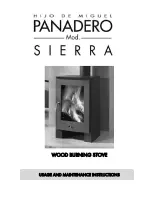
7
stove data table in accordance with en 13240 testing
Stove
type
Scan-Line
series
Nominal
fluegas
temperature,
at 20°C room
temperature
Smo-
ke
stub
mm
Fuel
volume
kg
Draught
min
mbar
Nominal
output
tested
kW
Heat
output
%
Distance to flamma-
ble materials in mm
behind at the
the stove sides
Distance to
furnitures from
the stove in
mm
Stove
weight
kg
SL 80XL soapstone
267 C
o
ø150
1,5
0,12
6,8
81
125 300
900
395
SL 80XL ceramics
267 C
o
ø150
1,5
0,12
6,8
81
125 300
900
311
80 XLB baking oven
soapstone
267 C
o
ø150
1,5
0,12
6,8
81
125 300
900
388
80 XLB baking oven
ceramics
267 C
o
ø150
1,5
0,12
6,8
81
125 300
900
308
The nominal output is the output to which the stove has been tested.
The test was carried out with the secondary air 80% open.
PUrPose oF the ConveCtion vent
Stoves in the Scan-Line 80 series are radiated-
heat stoves, which use several kilograms of
soapstone and stone mass to store heat. You
can get even more out of the stored heat by re-
gulating the convection air flow. Once the stove
has heated up, pull out the convection vent as
shown in Fig. 1 to close the vent and prevent
any more air from flowing through the stove.
The stove will then release the heat slowly into
the room over the next several hours.
oPerational ProBleMs
The chimney must be swept at least once a year,
we recommend the use of a NACS (national as-
sociation of chimney sweeps) registered chim-
ney sweep. In the event of smoke or malodo-
rous fumes being produced, you must first
check to see whether the chimney is blocked.
The chimney must, of course, always provide
the minimum draught necessary to ensure that
it is possible to regulate the fire. Please note,
however, that chimney draft is dependent on the
weather conditions. In high winds, the draft can
become so powerful that it may be necessary
to fit a damper in the flue gas pipe to regulate
the draft. When cleaning the chimney, soot and
other deposits may come to fall on the smoke
turning plate. In cases where the wood burns
too quickly, this may be due to excessive chim-
ney draught. You should also check to make
sure that the door seal is intact and correctly
fitting.
If the stove it generating too little heat, this may
be because you are firing with wet wood. In this
case, much of the heating energy is used to dry
the wood, resulting in poor heating economics
and an increased risk of soot deposits in the
chimney.
Check whether the air holes in the stones are
blocked with for example ashes etc. Below the
casted shaking grate is it possible to clean the
air channel for the start-up airflow.
1
Closed
Open
Summary of Contents for SCAN-LIINE 80 XL
Page 18: ...18 scan line 80 Xl and scan line 80 XlB ...
Page 28: ...28 ...








































